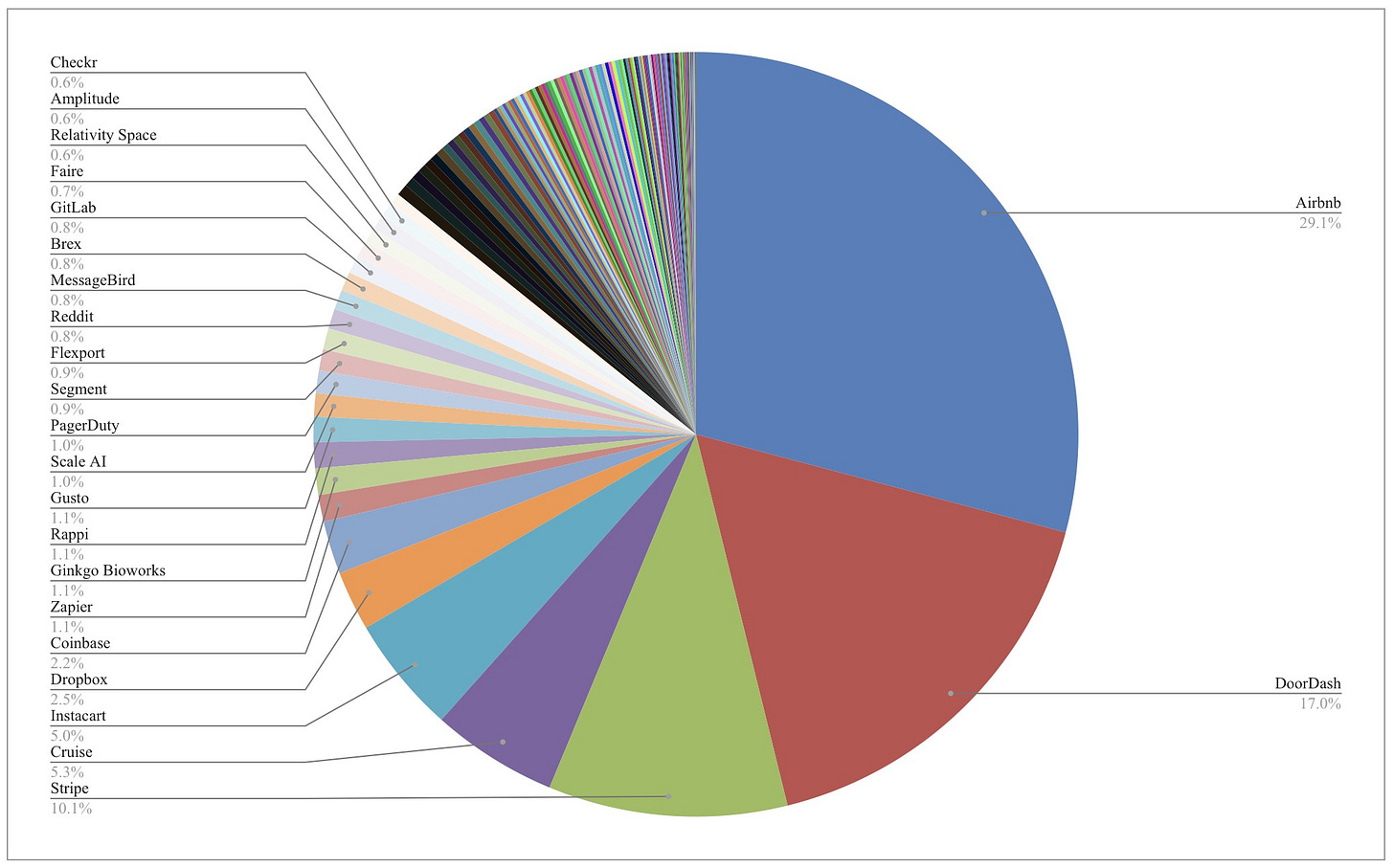Understanding Power Laws
In Wealth, Startups & Venture Capital
"The secret to maximising your odds of success is to choose the right field of competition.”
— James Clear
What Got Me Thinking 💭
✍️ Jared Heyman | On $300B of Y Combinator Startup Success
Most people are familiar with the normal distribution (a.k.a the Gaussian distribution) - if not conceptually, then through experience.
For example, consider exams results. There are three categories:
A few poor results;
A lot of average results; and
A few outstanding results.
However, not all things in life fit this distribution for various reasons. For example, some things follow power-law distributions. Here, there’s a functional relationship. When one contributing variable changes, there’s a proportional, relative change in the other.
Without getting too technical, this means that you get many low to medium results, with very few outliers.
Let’s check out some examples.
Example 1: The World’s Wealth Distribution
Consider the following facts:
1% of the world’s wealthiest own 50% of the world’s wealth;
10% of the world’s wealthiest own 85% of the world’s wealth; and
90% of the world’s most impoverished own 15% of the world’s wealth.
Wealth distribution follows power-law. The top 1% have equal wealth to the remaining 99% of the world combined. In this scenario, the top 1% are the “extreme outliers”, and everyone else forms the “vast majority”.
Example 2: Startups & Venture Capital
We always hear that “90% of the startups fail”. But even when startups succeed, they do so to varying degrees.
Y Combinator is an infamous startup accelerator. They’re known for training and investing in a curated set of founders. They have invested in more than 2500 startups. However, the returns follow the power-law distribution:
What do we notice? Well:
The top 3 companies account for over half of their returns. Meaning:
More specifically, 0.12% of their companies produce 56.2% of their returns.
Three companies, outperformed the remaining 2497 put together.
The top 10 companies produce 75% of their returns.
The bottom 99% of companies produce less than 15% of their returns.
Again, we see that Airbnb, Doordash and Stripe are YC’s “extreme outliers”. They are “the few” that immensely outperform “the many”.
Power-laws is why funds have to go for moonshots. Anything less than the best startups results in disproportionately low returns. The power laws naturally drive the returns by VC funds too.
There are ways to change this, e.g.:
Increase the number of outliers:
Improving diversity to boost the number of funded startups;
Increase the rate of good results through risk management (reducing the top end but improving the bottom end):
Less pressure on startups scaling in fast and unstainable ways — encouraging early profitability; and
VCs liquidating at earlier stages may also reduce the severity of the gradient.
With several promising disruptions taking place, I think we will see improved support at every stage for startups.
Final Thoughts
Whether we’re speaking about the 80-20 rule (a.k.a. the Pareto distribution) or winner-take-all markets, we’re talking about ideas driven by power laws. The benefit is that you realise the stakes at hand.
In some situations, it makes you more concerned about increasing the number of attempts — e.g. investing in or building startups.
Int other situations, it narrows your focus — e.g. the 80:20 rule.
Understanding the situation, the stakes and your risk appetite allows you to leverage power laws to the best of your advantage.
Yes - I’m The Plug 🔌
Audiblogs - Turn any blog into an audiobook/podcast (and it sounds excellent)
Lunchclub - Randomly get paired with people in tech for virtual meetings. I had my first two last week, and they were terrific!
Do You See What I See? 🗞👀
Elon Musk x Bitcoin x Dogecoin | Fraff And Serious
The world’s richest man has made many jokes on Twitter about Dogecoin — which many have taken seriously. However, his recent support for Bitcoin is no joke. Tesla invested $1.5 billion of the company’s cash reserves in Bitcoin. They haven’t got nearly as much cash many of the big tech giants (which makes this “risky”), but the signalling has paid off, pushing Bitcoin’s price up to an all-time high.
First, early adopters buy. Then Tesla and Square. Eventually, countries and many other companies around the world. “To the revolution!” — “Hamilton”
The Orginal Gamestop vs Robinhood | Apple Deemed Too Risky To Trade
The Gamestop fiasco raised many familiar questions about censorship, seeing as Robinhood (and eventually many other platforms) prevented people from purchasing the shares in the name of volatility. But guess what, the State of Massachusetts did the same thing to Apple in 1980. They said it was too risky.
Those in power have been wrong before. But it doesn’t stop the powerful from censoring everyone. This recurring issue presents an interesting potential use case for blockchain technology.
90% of Developer’s Job | So Much Fun And Pain In A Single Video. Enjoy!
🐦 Twitter | 🔗 LinkedIn | 👨💻 Indie Hackers | 🕵️♂️ Product Hunt | 📥 Personal Site








Another great issue.
So crazy that a CEO who is meant to be maximising shareholder value and preserving capital is willing to roll the dice.
Is Tesla a genius company employing with a Founder employing meme tactics to drive popularity and more retail investment?
If the Bitcoin thing pays off they will call him cutting edge, and innovator. If not, they will call him foolish